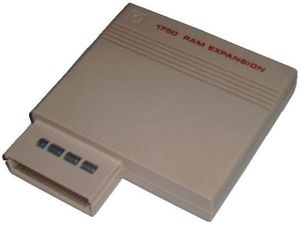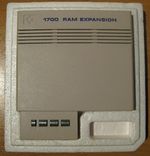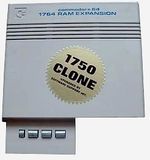Commodore REU
| Commodore REU | |
 | |
| Type: | REU |
| Producer: | Commodore |
| Price: | |
| Released: | 1985 |
| Discontinued: | 1993 |
| Processor: | MOS 6510/8500 @ 1 MHz |
| Memory: | 128 KByte, 256 KByte and 512 KByte, theoretical upgradable until 16 MByte. |
| OS: | |
| Info: | |
Commodore produced 3 REU (RAM Expansion Unit) models. These cartridge-based REUs increased the RAM available to the C128 and C64 by an additional 128 kByte, 256 kByte or 512 kByte. However, unofficial modifications implemented by third-party companies or hobbyists could increase this capacity to 2 MByte; albeit with some stability issues.
Contributors[edit | edit source]
Frank Palia designed the REU hardware. Victor Andrade designed the dedicated IC (Integrated Circuit). Fred Bowen and Terry Ryan adapted the Kernal and BASIC to accommodate the REU. Hedley Davis wrote the globe spinning demo.
Models[edit | edit source]
Officially, the 1700 REU and the 1750 REU were designed only for the C128 and the 1764 REU was designed only for the C64; however there was strong compatibility and all 3 were used on both machines. Nevertheless, any Commodore REU used on a C64 required additional power (the 1764 was bundled with a 2.5 ampere power supply) due to the draw by the additional ICs. The stock C64 power supply could not, but the C128 stock power supply could, supply all Commodore REUs. Some dealers unbundled the 1764 and the power supply in order to sell the power supply to C64 users, and/or upgrade the 1764 to 512 kByte. The value in bit 4 of $DF00 will reveal whether a 1750 is attached (value 1) or a 1700/1764 is attached (value 0). The only way to distinguish between a 1700 REU and a 1764 REU is to attempt a write to RAM in bank 2 or 3.
| Table 1 - Commodore REU Models | ||
|---|---|---|
| Model | Remarks | Image[1] |
| Commodore 1700 REU | - Designed for the C128 but works on the C64. - Contains 128 kByte RAM using 16 (1-bit) 64 kByte DRAM packages; 16 x 64 kByte / 8-bit = 128 kByte. - The RAM is controlled in two banks (0-1). |

|
| Commodore 1750 REU | - Designed for the C128 but works on the C64. - Contains 512 kByte RAM using 16 (1-bit) 256 kByte DRAM packages; 16 x 256 kByte / 8-bit = 512 kByte. - The RAM is controlled in eight banks (0-7). |

|
| Commodore 1764 REU | - Designed for the C64 but works on the C128 (albeit with timing issues) - Contains 256 kByte RAM using 8 (1-bit) 256 kByte DRAM packages; 8 x 256 kByte / 8-bit = 256 kByte. - The RAM is controlled in four banks (0-3). |

|
Hardware[edit | edit source]
All of the Commodore REUs are housed in an oversized cartridge case; each has different moulded title on the external uppermost face. Internally, the PCB and components are protected by a two-piece removable static shield. There are two different PCB variations but the difference is dependent upon which logic IC package (DIP or PLCC) is used, and not on the intended use or name of the REU. Each PCB is overprinted on the left of the uppermost edge with the title "C128 RAM EXPANSION". The two different PCB variations are overprinted on the right of the uppermost edge with "FAB NO 311753" (DIP logic IC) or "FAB NO 312535" (PLCC logic IC). There are locations on the PCB for two groups of 8 DRAM ICs per group. The embedded DRAM ICs are dependent upon the overall memory size of the REU. The logic IC is a MOS Technology 8726; in either a DIP (earliest version) or PLCC (later version) package. The trace marked J1 (and "CUT-512K") on the rear of the PCB indicated the size of the embedded DRAM chips: with 64 kByte 1-bit ICs the trace was left intact; with 256 kByte ICs the trace was cut. The trace marked R4 on the front of the PCB featured a resistor for C128 models which was lacking on the C64 model that, according to Commodore engineer Fred Bowen, compensated for subtle differences in the expansion port on the C64 and C128[2]. Fred Bowen and other Commodore engineers recommended against interchanging Commodore REUs between the C64 and C128 without making the appropriate change to R4.
Chipset[edit | edit source]
| Table 2 - Chipset of the Commodore REUs | |||||
|---|---|---|---|---|---|
| PCB ID | Type | Manufacturer | Code No | Pins | Remarks |
| U1 | REC | MOS Technology | MOS Technology 8726 R1 | 68-pin PLCC | |
| U2-U9 | DRAM | TMS (Texas Instruments Mixed Signals) | TMS4256-15NL or TMS4256-10NL | 16-pin DIP | 256 Kb for 1750 REU and 1764 REU |
| Siemens | KM41256-15 | 16-pin DIP | 256 Kb for 1750 REU and 1764 REU | ||
| 16-pin DIP | 64 Kb for 1700 REU | ||||
| U10-U17 | DRAM | TMS (Texas Instruments Mixed Signals) | TMS4256-15NL or TMS4256-10NL | 16-pin DIP | 256 Kb for 1750 REU only |
| Siemens | KM41256-15 | 16-pin DIP | 256 Kb for 1750 REU only | ||
| 16-pin DIP | 64 Kb for 1700 REU | ||||
| U18 | EPROM | n/a | n/a | 28-pin DIP | not supplied for all models |
Operation[edit | edit source]
The C128 featured the MOS Technology 8722 MMU (Memory Management Module) which enabled bankswitching. However for both the C128 and C64, data in the REU could only be accessed after a transfer between the computer's default RAM and the REU's RAM. This was achieved by a DMA (Direct Memory Access) user request and controlled by the logic of the MOS Technology 8726 REC (RAM Expansion Controller). The machine code instruction set is the same for all REUs on both machines. The BASIC 7.0 instruction set (STASH, FETCH, SWAP) is only available on the C128, and there is no native control for the REC on the C64.
Upgrade[edit | edit source]
Not many 1750 REUs were manufactured, due in most part to the IC shortages resulting from the late 1980's US-Japan trade pact. Therefore, in order to satiate the need for greater RAM, the upgrade of 1700 REU or 1764 REU to 512 kB became popular. Several firms did this commercially, either selling upgraded units or upgrading customer-supplied units[3]. This only increased the RAM to 512 kB, and it was not long before this was surpassed.
The ability to expand a C64 to 1 MB RAM was published by Paul Bosacki in August 1989[4]; but this was with a new circuit and not an expansion of an existing REU. The ability to expand the C64 and the C128 to 2 MB was published by Andrew Mileski in October 1989[5]; and this was by expansion of an existing REU.
References[edit | edit source]
- ↑ RAM Expansion Units from Commodore Designed for Commodore 128, accessed 29 December 2014
- ↑ Commodore REU, accessed 29 December 2014
- ↑ Commodore REU, accessed 29 December 2014
- ↑ The One Megabyte C64!, The Transactor, Volume 9, Issue 2, August 1989
- ↑ Beyond 512 kB: The Two Megabyte REU, accessed 29 December 2014
External Links[edit | edit source]
| Wikipedia: Commodore_REU |
| Wikipedia: Commodore_64_peripherals#RAM_expansions |